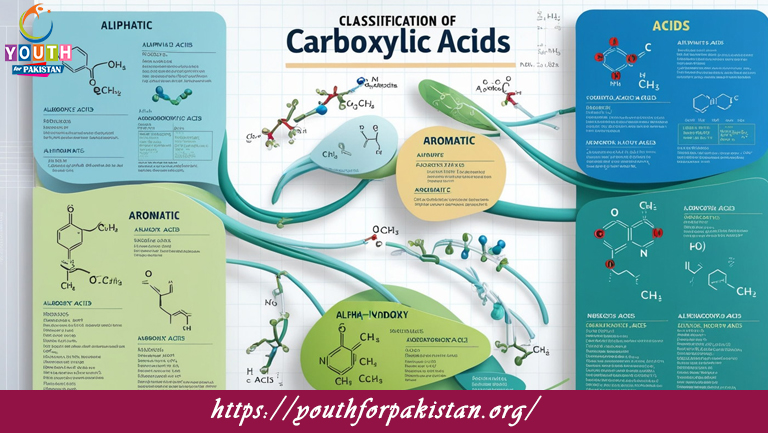Welcome to the Carboxylic Acids Classification MDCAT MCQs with Answers. In this post, we have shared Carboxylic Acids Classification Multiple Choice Questions and Answers for PMC MDCAT 2024. Each question in MDCAT Chemistry offers a chance to enhance your knowledge regarding Carboxylic Acids Classification MCQs in this MDCAT Online Test.
Carboxylic acids can be classified based on:
a) Their molecular weight
b) Their functional group
c) Their solubility
d) Their acidity
Which type of carboxylic acid has the carboxyl group attached to a carbon in a ring structure?
a) Aromatic carboxylic acids
b) Aliphatic carboxylic acids
c) Hydroxy acids
d) Dicarboxylic acids
What is the classification of carboxylic acids that contain two carboxyl groups?
a) Monocarboxylic acids
b) Dicarboxylic acids
c) Tricarboxylic acids
d) Polycarboxylic acids
Carboxylic acids containing more than one carboxyl group are known as:
a) Monocarboxylic acids
b) Dicarboxylic acids
c) Polycarboxylic acids
d) Tricarboxylic acids
An example of an aromatic carboxylic acid is:
a) Acetic acid
b) Benzoic acid
c) Butanoic acid
d) Propanoic acid
Which of the following is an aliphatic carboxylic acid?
a) Phthalic acid
b) Tartaric acid
c) Lactic acid
d) Benzoic acid
Which type of carboxylic acid is characterized by having a carboxyl group attached to a benzene ring?
a) Aromatic carboxylic acids
b) Aliphatic carboxylic acids
c) Hydroxy acids
d) Dicarboxylic acids
The classification of carboxylic acids based on the number of carboxyl groups includes:
a) Monocarboxylic, Dicarboxylic, Tricarboxylic, and Polycarboxylic
b) Saturated and Unsaturated
c) Linear and Branched
d) Simple and Complex
Carboxylic acids with a hydroxyl group adjacent to the carboxyl group are called:
a) Hydroxy acids
b) Alpha-hydroxy acids
c) Beta-hydroxy acids
d) Gamma-hydroxy acids
Which of the following is a polycarboxylic acid?
a) Acetic acid
b) Oxalic acid
c) Formic acid
d) Benzoic acid
A carboxylic acid with a carboxyl group attached directly to a phenyl ring is classified as:
a) Aromatic carboxylic acid
b) Aliphatic carboxylic acid
c) Dicarboxylic acid
d) Hydroxy acid
Which type of carboxylic acid is found in fruits and dairy products?
a) Aliphatic carboxylic acids
b) Aromatic carboxylic acids
c) Hydroxy acids
d) Fatty acids
A carboxylic acid with two carboxyl groups separated by a single carbon is called:
a) Oxalic acid
b) Malonic acid
c) Succinic acid
d) Glutaric acid
The classification of carboxylic acids with only one carboxyl group is known as:
a) Dicarboxylic acids
b) Polycarboxylic acids
c) Monocarboxylic acids
d) Tricarboxylic acids
Carboxylic acids that contain a carboxyl group and a hydroxyl group on adjacent carbons are called:
a) Alpha-hydroxy acids
b) Beta-hydroxy acids
c) Gamma-hydroxy acids
d) Omega-hydroxy acids
Which of the following carboxylic acids is classified as a fatty acid?
a) Acetic acid
b) Palmitic acid
c) Citric acid
d) Malic acid
A carboxylic acid that contains a carboxyl group attached to a phenyl ring is known as:
a) Benzene carboxylic acid
b) Toluic acid
c) Salicylic acid
d) Benzoic acid
Carboxylic acids with a carboxyl group attached to an alkyl chain are classified as:
a) Aromatic carboxylic acids
b) Aliphatic carboxylic acids
c) Hydroxy acids
d) Polycarboxylic acids
Which classification of carboxylic acids has three carboxyl groups?
a) Monocarboxylic acids
b) Dicarboxylic acids
c) Tricarboxylic acids
d) Polycarboxylic acids
The classification of carboxylic acids based on the position of carboxyl groups on the ring includes:
a) Ortho, meta, and para
b) Alpha, beta, and gamma
c) Mono, di, and tri
d) Primary, secondary, and tertiary
Which of the following carboxylic acids is an example of a dicarboxylic acid?
a) Acetic acid
b) Oxalic acid
c) Citric acid
d) Butanoic acid
Which of the following acids is classified as a tricarboxylic acid?
a) Oxalic acid
b) Citric acid
c) Succinic acid
d) Malonic acid
Which type of carboxylic acid is known for its use in the synthesis of polymers and resins?
a) Aliphatic carboxylic acids
b) Aromatic carboxylic acids
c) Hydroxy acids
d) Fatty acids
Carboxylic acids containing a phenyl group attached to the carboxyl group are known as:
a) Aliphatic carboxylic acids
b) Aromatic carboxylic acids
c) Hydroxy acids
d) Dicarboxylic acids
A carboxylic acid with three carboxyl groups on the same molecule is known as:
a) Tricarboxylic acid
b) Dicarboxylic acid
c) Monocarboxylic acid
d) Polycarboxylic acid
Which of the following acids is classified as a hydroxy acid?
a) Lactic acid
b) Benzoic acid
c) Acetic acid
d) Formic acid
Which classification of carboxylic acids contains a carboxyl group attached to a ring structure with additional substituents?
a) Aromatic carboxylic acids
b) Aliphatic carboxylic acids
c) Dicarboxylic acids
d) Polycarboxylic acids
The classification of carboxylic acids with a carboxyl group and a hydroxyl group on adjacent carbons includes:
a) Alpha-hydroxy acids
b) Beta-hydroxy acids
c) Gamma-hydroxy acids
d) Omega-hydroxy acids
The classification of carboxylic acids with more than one carboxyl group includes:
a) Monocarboxylic acids
b) Dicarboxylic acids
c) Tricarboxylic acids
d) Polycarboxylic acids
Which type of carboxylic acid contains two carboxyl groups on the same molecule?
a) Dicarboxylic acid
b) Monocarboxylic acid
c) Tricarboxylic acid
d) Polycarboxylic acid
Which of the following is a feature of hydroxy acids?
a) Contain two carboxyl groups
b) Contain one carboxyl group and one hydroxyl group
c) Contain only one carboxyl group
d) Contain a phenyl ring
Carboxylic acids with a carboxyl group directly attached to a phenyl ring are known as:
a) Aromatic carboxylic acids
b) Aliphatic carboxylic acids
c) Polycarboxylic acids
d) Hydroxy acids
Which carboxylic acid is used in the production of aspirin?
a) Acetic acid
b) Salicylic acid
c) Citric acid
d) Oxalic acid
The classification of carboxylic acids with more than two carboxyl groups is known as:
a) Monocarboxylic acids
b) Dicarboxylic acids
c) Tricarboxylic acids
d) Polycarboxylic acids
Which of the following is a common classification of carboxylic acids based on their structure?
a) Monocarboxylic
b) Aromatic
c) Hydroxy
d) All of the above
Which type of carboxylic acid is commonly found in citric fruits?
a) Monocarboxylic acids
b) Dicarboxylic acids
c) Tricarboxylic acids
d) Hydroxy acids
The classification of carboxylic acids containing a phenyl group attached to the carboxyl group is:
a) Aromatic carboxylic acids
b) Aliphatic carboxylic acids
c) Hydroxy acids
d) Polycarboxylic acids
Which type of carboxylic acid is characterized by having a single carboxyl group and a hydroxyl group on adjacent carbon atoms?
a) Beta-hydroxy acid
b) Alpha-hydroxy acid
c) Gamma-hydroxy acid
d) Delta-hydroxy acid
A common carboxylic acid found in vinegar is classified as:
a) Monocarboxylic acid
b) Dicarboxylic acid
c) Tricarboxylic acid
d) Polycarboxylic acid
The classification of carboxylic acids based on their number of carboxyl groups and presence of other functional groups includes:
a) Monocarboxylic, Dicarboxylic, Tricarboxylic, and Hydroxy acids
b) Aliphatic, Aromatic, and Polycarboxylic
c) Saturated and Unsaturated
d) Linear and Branched
If you are interested to enhance your knowledge regarding Physics, Chemistry, Computer, and Biology please click on the link of each category, you will be redirected to dedicated website for each category.








